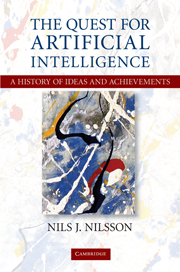Book contents
- Frontmatter
- Contents
- Preface
- PART I BEGINNINGS
- PART II EARLY EXPLORATIONS: 1950S AND 1960S
- 3 Gatherings
- 4 Pattern Recognition
- 5 Early Heuristic Programs
- 6 Semantic Representations
- 7 Natural Language Processing
- 8 1960s' Infrastructure
- PART III EFFLORESCENCE: MID-1960S TO MID-1970S
- PART IV APPLICATIONS AND SPECIALIZATIONS: 1970s TO EARLY 1980s
- PART V “NEW-GENERATION” PROJECT
- PART VI ENTR'ACTE
- PART VII THE GROWING ARMAMENTARIUM: FROM THE 1980s ONWARD
- PART VIII MODERN AI: TODAY AND TOMORROW
- Index
- Plate section
6 - Semantic Representations
Published online by Cambridge University Press: 05 August 2013
- Frontmatter
- Contents
- Preface
- PART I BEGINNINGS
- PART II EARLY EXPLORATIONS: 1950S AND 1960S
- 3 Gatherings
- 4 Pattern Recognition
- 5 Early Heuristic Programs
- 6 Semantic Representations
- 7 Natural Language Processing
- 8 1960s' Infrastructure
- PART III EFFLORESCENCE: MID-1960S TO MID-1970S
- PART IV APPLICATIONS AND SPECIALIZATIONS: 1970s TO EARLY 1980s
- PART V “NEW-GENERATION” PROJECT
- PART VI ENTR'ACTE
- PART VII THE GROWING ARMAMENTARIUM: FROM THE 1980s ONWARD
- PART VIII MODERN AI: TODAY AND TOMORROW
- Index
- Plate section
Summary
The computer programs i have described so far performed transformation on relatively simple symbol structures, which were all that were required for the mathematical problems, puzzles, and games that these programs dealt with. The main effort was in coming up with and using problem-specific heuristics (such as features to be used in computing the value of a checkers position, for example) to limit the number of transformations of these structures in searches for solutions. As Minsky put it, “The most central idea of the pre-1962 period was that of finding heuristic devices to control the breadth of a trial-and-error search.” In the early 1960s, several Ph.D. research projects, some performed under Minsky's direction at MIT, began to employ more complex symbol structures in programs for performing various intellectual tasks. Because of their rich, articulated content of information about their problem topic, these structures were called semantic representations. As Minsky wrote, “Within the small domain in which each program operates, the performance [of these programs] is not too bad compared with some human activities.… But much more important than what these particular experiments achieve are the methods they use to achieve what they do, for each is a first trial of previously untested ideas.” I'll describe some examples of these sorts of projects and the new methods that they employed.
Solving Geometric Analogy Problems
Thomas G. Evans (1934–) programmed a system that was able to perform well on some standard geometric analogy tests. It was apparently the largest program written up to that time in John McCarthy's new programming language, LISP (which I'll describe later).
- Type
- Chapter
- Information
- The Quest for Artificial Intelligence , pp. 96 - 102Publisher: Cambridge University PressPrint publication year: 2009



